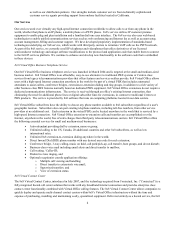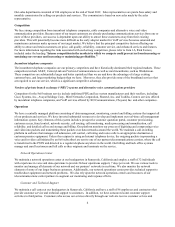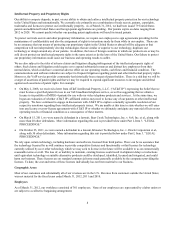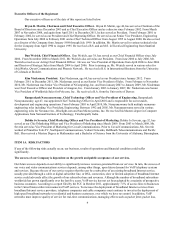8x8 2012 Annual Report Download - page 13
Download and view the complete annual report
Please find page 13 of the 2012 8x8 annual report below. You can navigate through the pages in the report by either clicking on the pages listed below, or by using the keyword search tool below to find specific information within the annual report.
11
management; and (3) prevent broadband Internet access providers from unreasonably discriminating in the transmission of
lawful network traffic over a consumer's broadband Internet access service. The FCC rules became effective on November 20,
2011. Numerous parties have appealed these rules which have been consolidated before the U.S. Court of Appeals for the
District of Columbia. We cannot predict the outcome of these appeals or the impact of these rules on our business at this time.
Although we believe interference with access to our products and services is unlikely, broadband Internet access provider
interference has occurred, in limited circumstances in the U.S., and could result in a loss of existing users and increased costs,
and could impair our ability to attract new users, thereby negatively impacting our revenue and growth.
Intense competition in the markets in which we compete could prevent us from increasing or sustaining our revenue
and increasing or maintaining profitability.
The telecommunications industry is highly competitive. We face intense competition from traditional telephone companies,
wireless companies, cable companies, competitive local exchange carriers, alternative voice communication providers and
independent VoIP providers. In addition, our customers are not subject to long-term contractual commitments to purchase our
services and can terminate our service and switch to competitors’ offerings on short notice.
Most of our current and potential competitors, particularly incumbent telephone and cable companies, have longer operating
histories, significantly greater resources and name recognition, and a larger base of customers than we have. As a result, these
competitors may have greater credibility with our existing and potential customers. They also may be able to adopt more
aggressive pricing policies and devote greater resources to the development, promotion and sale of their products than we can
to ours. Our competitors may also offer bundled service arrangements offering a more complete product despite the technical
merits or advantages of our products. Competition could decrease our prices, reduce our sales, lower our gross profits or
decrease our market share.
We also compete against established alternative voice communication providers and face competition from other large, well-
capitalized Internet companies that have recently launched or plan to launch VoIP-enabled services. In addition, we compete
with independent VoIP service providers. Some of these service providers may choose to sacrifice revenue in order to gain
market share by offering their services at lower prices or for free. In order to compete with such service providers, we may
have to significantly reduce our prices, which would affect our profitability.
We also are subject to the risk that new technologies may be developed that are able to deliver competing voice services at
lower prices, better or more conveniently. Future competition from new technologies could have a material adverse effect on
our growth and operating results.
Given the significant price competition in the markets for our products, we are at a significant disadvantage compared to many
of our competitors, especially those with substantially greater resources, and therefore may be better able to withstand an
extended period of downward pricing pressure. The adverse impact of a shortfall in our revenues may be magnified by our
inability to adjust spending to compensate for such shortfall. Announcements of new products and technologies by our
competitors or us could cause customers to defer purchases of our existing products, which also could have a material adverse
effect on our business, financial condition or operating results.
The VoIP telephony market is subject to rapid technological change, and we depend on new product and service
introductions in order to maintain and grow our business.
VoIP telephony is an emerging market that is characterized by rapid changes in customer requirements, frequent introductions
of new and enhanced products, and continuing and rapid technological advancement. To compete successfully in this emerging
market, we must continue to design, develop, manufacture, and sell new and enhanced VoIP telephony software products and
services that provide increasingly higher levels of performance and reliability at lower cost.
Decreasing telecommunications rates and increasing regulatory charges may diminish or eliminate our competitive
pricing advantage.
Decreasing telecommunications rates may diminish or eliminate the competitive pricing advantage of our services, while
increased regulation and the imposition of additional regulatory funding obligations at the federal, state and local level could
require us to either increase the retail price for our services, thus making us less competitive, or absorb such costs, thus
decreasing our profit margins. International and domestic telecommunications rates have decreased significantly over the last
few years in most of the markets in which we operate, and we anticipate these rates will continue to decline in all of the
markets in which we do business or expect to do business. Users who select our services to take advantage of the current
pricing differential between traditional telecommunications rates and our rates may switch to traditional telecommunications
























